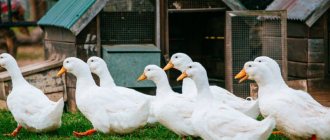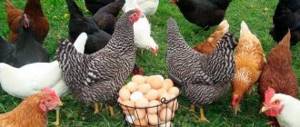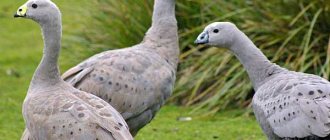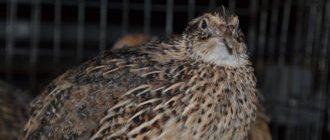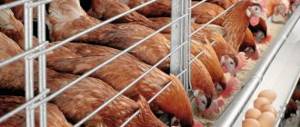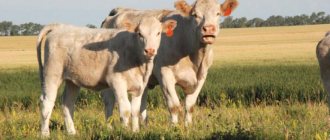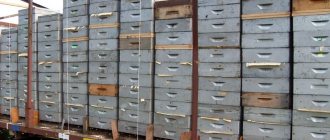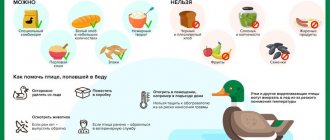Purchasing young stock
The cheapest way is to buy peacock eggs and give them to hens to hatch. But then you will have to wait a long time until the chicks grow up and begin to mate. It is profitable to purchase young animals aged 1-2 years. Price is around $60-90 per head.
The most common breeds in Russia and Ukraine are: common (blue, black-winged, white), Javanese.
It is necessary to buy young animals at the rate of one male for two or three females, since they are kept by families. Initially, it is enough to purchase two males and six females. It's 600$.
Housing
In the southern regions, it is possible to organize the keeping of peacocks on a personal plot all year round. Features of these animals: they do not get along with other species (they cannot be “added” to chickens or pheasants) and do not tolerate competition. Each family with one male must live separately from the other.
Setting up an enclosure for peacocks
In captivity, separate enclosures are set up for birds. Dimensions: width and length 5 m each, height - about 3 m. This height is necessary to build perches at a level of 1.5 meters above the ground so that your pets do not damage their gorgeous tails. The walls of the walking area are made of metal mesh.
The bottom should be covered with calcined sand or shell rock with a layer of 8-10 cm. Set aside about a square meter for an area with ash, which will become a bird bath. Feeders and drinking bowls should also be placed here.
Poultry house
This is a kind of home for your pets. Several exits should be made from them into enclosures in the form of windows the width of an adult male. Typically, a poultry house is initially set up in a barn, to which a walking area is subsequently added. Approximate dimensions of the houses: 2x3 meters or 5x3 meters.
Each family ideally needs a separate house. The floor is covered with dry straw sprinkled with lime. This is necessary so that the straw does not become damp, otherwise the animals will be plagued by numerous parasites. Perches and nests are needed inside. This will avoid losing valuable eggs.
The easiest way is to make nests from wooden boxes or wicker baskets (this provides excellent ventilation). Approximate size of the nest: 50x60 cm in width and length and about 70 cm in depth. The bottom is covered with straw or sawdust.
Place to stay
The area for the aviary and the size of the poultry house depend on the number of birds. Typically, an area of 5 by 5 meters is allocated for the pen. A wire fence is stretched around it to a height of 3 m. A canopy on top is mandatory, otherwise the birds will fly out. Perches are made at a distance of one and a half meters from the ground. A lower height is unacceptable as the tail may be damaged. Based on this principle, an enclosure for the peacocks in the photo shown is built.
To make a perch, strong bars with a cross section of 5 by 10 cm are used. The upper part of the poles should be flat. This shape helps create the most comfortable conditions for a sitting bird. Her paws reliably cover her feathers and prevent them from freezing in the cold.
The bottom of the enclosure is covered with a thick layer (8-10 cm) of shell rock or sand. They are pre-calcined for disinfection. To clean their plumage, birds need ash; an area of up to 1 square meter is allocated for it in the pen. m. A feeder and a drinking bowl are placed in the enclosure.
Directly adjacent to the walk is the poultry house where the pets live. They build houses with dimensions of 2 by 3 or 5 by 3 meters. Each couple is placed in a separate box. Perches and nests are attached inside. The floor in the compartment is covered with bedding, which is changed as it gets dirty. Straw sprinkled with lime is used as a bedding material. Lime absorbs moisture and prevents rapid rotting of the straw filler.
The role of nests in a peacock's home is played by baskets or wooden boxes.
The most suitable trays are the following sizes:
- length - 0.6 m;
- width - 0.5 m;
- depth – 0.7 m.
A straw bedding or sawdust is poured inside.
Conditions for keeping peacocks
To do this business at the proper level, you will need to purchase several heaters to maintain the desired temperature in the poultry houses. At temperatures down to -1 degree the bird feels good, at -5 degrees and below it freezes. That is why keeping peacocks in winter requires constant checking of the temperature regime. In winter, the birds live in houses and are released into the aviary for a short walk. In summer they can live outside 24 hours a day.
The main part of the diet is grain crops (corn, oatmeal, sunflower cake). The rest is wet mash. It includes:
- Boiled potatoes;
- Chopped fresh greens (nettle, dandelions, clover, alfalfa);
- Grated vegetables and kitchen waste (bread, minced meat, porridge).
A pinch of salt with chalk or lime should be added to the food as a mineral supplement.
Raising peacocks requires two meals a day. Wet food is given in the morning and grain mixtures in the evening. But during the period of mating and molting (in September), nutrition should be increased - up to three times a day. In winter, it is recommended to add sprouted grains to your morning diet. On average, an adult consumes 200 grams of grain feed and 400 g of mash per day.
to the chicks’ diet for rapid growth.
Peacock feeding
An important condition for breeding peacocks at home is proper nutrition. The diet of birds must contain all the substances necessary for normal life. Feeding twice a day is practiced. The morning menu consists of wet food (400 g). The evening meal includes cereal mixtures (200 g). In total, the daily ration is 600 g. During the mating season (September), the daily norm is increased and divided into 3 servings.
Peacocks happily peck corn, oatmeal, and sunflower cake. To prepare wet food, vegetables, herbs, and food waste are used: boiled potatoes, porridge, bread, dandelions, nettles, clover, alfalfa. In winter, the lack of greenery is compensated for by sprouted grains. To make it convenient for the birds to eat the food, all ingredients are crushed. It is useful to add lime, chalk, and salt to food.
Deworming is carried out every 3 months to rid the birds of internal parasites. Preparations intended for livestock are used as therapeutic agents.
Chicks need vitamin mixtures for active growth and weight gain. They are also given cottage cheese, ground bran, and small worms. Birds must have constant access to clean drinking water.
Reproduction
Adults begin to mate when they reach 1-2 years of age. The female lays 20-30 eggs during one mating period (their number can reach 2-3 times a year). Be sure to keep an eye on the masonry. Sometimes you have to look for eggs throughout the house and transfer them to the nest yourself. If the mother refuses to hatch them, the eggs are placed next to the chicken or in an incubator. Breeding peacocks in an incubator involves additional costs.
It is recommended that the hatched chicks be placed with their mother in a separate enclosure for several months. When the chicks reach eight months of age, they are also separated into separate houses to avoid conflicts. You shouldn't mate "relatives".
Breeding and keeping peacocks
Why raise peacocks when you can replace them with chickens or ducks? Firstly, for the aesthetic decoration of the site. Secondly, peacocks have unusual meat that is very tasty. Thirdly, peacock eggs taste different from chicken eggs or from the eggs of other birds, but besides this they are very healthy. This article will help you learn how to care for, feed and breed birds at home. In addition, detailed information can be found in the videos presented in the article.
Interesting Facts
Peacocks are large birds that are also considered to be in the pheasant family. Peacocks have a large and beautiful tail, which is considered the most beautiful among large birds. Initially, successful Chinese, Indians and some people in Europe began breeding birds. The hatching was carried out solely for the decoration of their plots. Thanks to their colors, the birds gave the desired status to their owners. Females have slightly less body weight, but their plumage is completely different.
Adults can have a harem, which includes 5 peahens. To distinguish a male from a female, you just need to look at their colors. Males have brighter colors and more feathers near the tail. Besides. Their feathers are longer and their body mass is greater, which is visually visible. It will be possible to find out the sex of birds only after a month after birth.
Peacocks are long-lived; the oldest resident, who was 50 years old, was recorded. Keeping peacocks at home is usually a minimum of 4 years and up to 15 years.
Incubation, care of young animals
After laying eggs, the female often forgets about them, so difficulties arise in producing offspring. The hatching peacock egg is placed on another poultry bird for incubation. Many breeders also use special chambers where the required thermal conditions are maintained (+37.2-37.7 ° C).
Pecking begins on days 28-29. Chicks are covered with feathers from birth. However, at first they must be kept at a temperature of +36° C. Heating is gradually reduced by 2-3° per week. A peahen looks after the young animals. At the age of 1 month, the sex of the chicks is determined, and at 8 months they are placed in separate boxes.
Raising peacocks at home often turns into a full-fledged business. Engaging in it requires a significant investment (approximately 200 thousand rubles). Funds are spent on purchasing young animals or eggs, purchasing feed and bedding, and paying for electricity. Exotic poultry farming becomes profitable after 5-7 years. On average, 1 adult individual allows you to get over $100 in net profit.
Incubation
If you are hatching birds through an incubator, you will need to know that egg incubation is from 27 days to 30 days, at a temperature of 37.2-37.5 degrees for a dry thermometer. For a wet bulb thermometer, the temperature should be 28.9-29.4 degrees. To hatch through an incubator, you will need to use only fresh eggs or eggs that are no more than 10 days old.
If natural hatching methods are used for hatching, then you can lay a duck or even a chicken. The peacocks themselves hatch their eggs only 2 times a year.
Baby birds are born already with plumage, which cannot be said about other species of birds. In addition, small peacocks can take flight after 7 days of birth.
Poultry house for kids
Keeping peacocks after hatching is a very important stage, since the percentage of survival directly depends on the conditions in which they will be kept during the first 60 days. It is worth noting that for successful hatching it is necessary to create heating for the poultry house. The temperature in it should be around 36 degrees at the initial stage of the puppets’ life. The temperature should be lowered at certain intervals. To do this, every week for 2 months you should reduce the degrees by 2-3 units. After 60 days, the heating can be removed. Babies grow quickly, which means they eat a lot of food. This should be taken into account when raising birds at home. Because of this, their feeders need to be constantly replenished with food. And regularly pour water into the drinking bowls or change it to new, clean water.
In the poultry house, feeders with drinkers can be placed directly on the wall. You can also make holes in the wall itself to replenish them without entering the house. It is also recommended to create perches in the poultry house that can be installed in two tiers. Breeding peoncocks requires a secure house so that other animals do not disturb the cubs.
In the case where the eggs were hatched by the peahen herself, she will need to be given special attention in the first week after the end of the incubation process. To do this, she will need to be completely protected from other birds and animals in order to preserve her offspring.
Poultry house arrangement
A barn for keeping peacocks is usually built on the north side. The height of the poultry house ceiling is about three meters, with a length and width of two and a half meters. The poultry house must communicate with the aviary using special manholes equipped with a removable door. If necessary, the entrance is blocked. In the barn it is necessary to place several perches, as well as nests.
For peacocks, nests are made quite voluminous - up to 75 cm deep, width and height from 50 to 65 cm.
Usually, boxes or baskets are used to arrange a nest, which are lined with straw and large sawdust from the inside.
The barn must have good ventilation, lighting and heating. During cold weather, birds need a comfortable temperature and dry, fresh air. They do not tolerate dampness and drafts well. For a comfortable stay, peacocks need a temperature of +18 + 20 degrees with a humidity of about 60%. Lower air humidity makes birds constantly thirsty and leads to digestive problems, while higher humidity threatens colds and problems with plumage. Even in frosty winters, many breeders recommend letting birds out for walks during the daytime. They can easily tolerate frosts down to -25 degrees, however, for birds that regularly walk in winter, chopped lard and minced meat will be a necessary supplement to their diet.
Reproduction
In the birds described, the breeding process is quite long, so it begins in March and continues until August. The best offspring can be produced by young and strong peahens. If one parent begins to lose feathers, the offspring can be expected to be frail and possibly even die.
It should be noted that such birds can often form strong pairs. However, such duets do not need to be broken up.
Breeding peacocks is not a quick process. Because in the first year of life the female will not lay eggs. But with age, it will be possible to receive eggs from birds on a regular basis, but with an interval of 2-3 days. If breeding is carried out naturally, the peahen will be able to sit on eggs only if their number is from 4 to 12 pieces. In order for breeding to proceed faster, you will need to incubate the eggs yourself. And to increase egg production and obtain eggs throughout the mating season, you need to remove them from the nest in time. In addition, it should be remembered that not all peacock eggs can be used to hatch offspring.
Breeding peacocks at home
In order to breed peacocks at home, experienced poultry farmers advise purchasing individuals no older than 2 years of age. To create full-fledged families, the following proportions are followed: 1 male to 5 females. Occasionally a ratio of 2:6 is allowed.
When choosing young animals, you need to be careful not to make a mistake with the color. The plumage acquires a stable color at 2 years. The color scheme is inherited from the parents. By crossing individuals of different shades, up to 185 variations in feather color can be achieved.
Before reaching sexual maturity, peacocks must be raised for several years and be prepared for difficulties in obtaining offspring. Future breeders need to know at what age peacocks begin laying eggs. In males, reproductive age occurs at 2-3 years, in females at 2 years. During 1 mating cycle, the peahen lays approximately 30 eggs.
The mating season covers the entire warm season (March-August). Birds form pairs. After mating, peacocks begin to molt. Fallen feathers are collected and sold for an average of 35 rubles. a piece. If desired, you can make a variety of souvenirs and decorations from them.
Pronounced sounds
It should be borne in mind that birds create different sounds during the mating season, which can significantly reduce the desire to breed them in the garden. They can start creating sounds from early morning until night. Moreover, these sounds are vile and very loud. They can be heard even several kilometers away. As a rule, males create the sound; females can also do this, but their voice is more pleasant and quieter. You can see and hear how the birds scream in the video.
Peculiarities of bird breeding Birds should be purchased in summer and spring. This will allow the birds to settle into their new habitat before winter. Young animals do not tolerate winter well, therefore, if the purchase was in winter, then their house should be heated and dry. When purchasing, you should pay attention to cleanliness:
All these parameters indicate a healthy individual. The feather cover should be shiny.
Nutrition
These animals are not picky when it comes to food. Therefore, breeding at home will be much easier than with other birds. They eat whatever is given to them. As a rule, grains of different varieties, larvae and insects, vegetables, fruits and even fish are used. Peacocks are like pigs; whatever they give, they will eat. Only babies require special nutrition.
For puppies, balanced feed is used, as for broiler chickens. You can also use dog food, but this type of food is not recommended. But such food helps the peacocks get the necessary substances in winter and autumn. It is also recommended to give babies calcium and eggshells.
For six months after birth, peacock cubs need to be given medications for coccidiosis. It is also recommended to feed boiled eggs, oatmeal, and dairy products. Dehydration is the most common problem that leads to death.
The video will allow you to see how birds are bred and kept on the site.
Litter
Dried straw or sawdust from pine trees is an excellent bedding material. The most important thing is that the bedding absorbs moisture and protects the paws from the floor covering.
Since birds eat anything, peacocks should be protected from various parasites and helminths. For prevention, it is recommended to give them medications at least 4 times a year. Medicines may be in tablet or liquid form. It should also be noted that similar medications can be used as those given to pigs and other livestock.
Medicines must be used strictly according to the instructions, based on the live weight of the bird.
Breeding such a bird must include loving them. Therefore, you should make them comfortable conditions, ensure peace of mind and protection from animals. The provided video and description will allow each person to successfully keep, breed and feed peacocks.
general characteristics
According to biologists, peacocks belong to the pheasant family and the order Galliformes. They also distinguish two species of these birds: the common peacock, domesticated by humans, and the green peacock. The close relationship with chickens is the reason for the similar living conditions of these birds. Peacocks are unpretentious and adapt well to cold weather, withstanding temperatures down to -33˚C. These birds live a long time; with good care, an individual can live up to 25 years.
Peacock in the wild
The habitat of wild peacocks is located on the shores of the Indian Ocean. From there they were brought to Palestine, Egypt and Asia Minor for the sake of beauty and meat, and came to Europe through Rome back in the Iron Age.
Appearance
The main distinguishing feature of the peacock is the upper covert feathers, which reach 120-160 cm in length. This is the same “tail” that males spread to attract females. Strictly speaking, scientists do not fully know all the reasons why a trail of feathers unfolds into a fan that is striking in its beauty. Sometimes the peacock uses this to defend its territory in the fight against other males, sometimes as a means of communication between birds.
According to one version, the male peacock spreads his tail to attract a female.
The wings of peacocks are large, their size is comparable to the length of the upper covert feathers. Moreover, the wings are fully functional and allow individuals to fly from the ground to a height of up to 15 meters. However, the peacock cannot stay in flight for long.
Peacock in flight
Females and males differ not only in the presence of a tail plume. Females are smaller, their length varies between 90-100 cm, while males reach 125 cm in length, not including coverts. The plumage of females, as a rule, is not so rich.
Male and female peacock
Types of plumage
Peacocks, which are bred at home, belong to the common species. This species is monotypic, that is, it is not divided into other subspecies. The entire spectrum of color is determined by mutations and crossings and has dozens of different options. Registration of possible colors has been carried out since the 20s of the 19th century.
In 2005, the United Peafowl Association described ten primary color variations and five secondary ones.
Benefits of eggs
Peacock eggs can be used for food; preparing them is no more difficult than chicken eggs. But in terms of calorie content, the product from these beautiful birds exceeds the product of ordinary laying hens: 770 kcal per 100 grams. According to the observations of chefs, the yolks of eggs are quite large, and the white has a delicate taste.
Eggs obtained from peacocks are not suitable for raw consumption. A person who has tried this delicacy runs a high risk of contracting such an unpleasant disease as salmonellosis.
Female peacock with a clutch of eggs
If we talk about breeding peacocks for the purpose of obtaining eggs, then this business is as “profitable” as fattening them for meat. Chickens cannot boast of stable and large clutches. Females begin laying eggs in April and lay a maximum of 3 dozen eggs by July. Most of the production will be used for incubation, so there is no point in offering eggs for sale. It is worth noting that the hatchability of chicks in these birds leaves much to be desired, and therefore the remainder of the eggs can also be used to hatch young animals.
Why breed peacocks?
These birds, as a rule, are bred for decorative purposes, so few farmers pay attention to their food characteristics. However, you can get more than just aesthetic pleasure from a flock of peacocks.
In some Florida towns, peacocks are bothering locals
Yes, they eat peacock meat. However, dishes made from this meat are served in expensive restaurants, because in terms of cost it is much more expensive than turkey meat, and not every gourmet can understand the difference in taste. It takes a very long time for a male to gain weight; it may take two years to fatten him up to 4 kg. Therefore, if you plan to breed this bird, do not expect to make a lot of income from selling meat. Only very large and rich farms can afford this.
Peacock eggs are also eaten. They are prepared like chicken eggs, although the calorie content of a peacock egg is much higher - 700 kcal versus 157 kcal per 100 g. Chefs note that the peacock egg has a fairly large yolk and delicate white.
By the way! Unlike a chicken egg, a peacock egg cannot be eaten raw - there is a high risk of contracting salmonellosis.
But raising a peacock for eggs is just as unprofitable. The fact is that female peacocks lay unsteadily and little. One female in the period from April to July can lay, at best, up to 30 eggs. Considering that some of the eggs will be selected for incubation (and the risk of losing the entire brood is quite high), in a year you will only be able to eat a couple of pans of fried eggs.
Feathers
Perhaps this is the only reason to breed peacocks, if you do not take into account the sale of young animals as pets. The beauty of peacock feathers inspires many needlewomen to create various accessories and crafts. Feathers, depending on the length, type of color (natural and dyed) and quality, can cost from 35 rubles per piece. Not only the covert feathers are valued, but also all other plumage of birds.
Dream catcher with peacock feathers
Peacock feathers are in demand among needlewomen
You can sell feathers, or you can organize a workshop on the basis of the farm and sell products made from them.
Sale of young animals
Peacock breeders can be roughly divided into two groups: those who keep several birds as pets, and those who sell them first. If you just want to have a peacock as a decoration for your yard, then listen to how it screams (and you need to listen in the spring, in March-April, when the instincts of the male are especially strong) - not all people can withstand the full range of sounds that peahens make. Although a number of breeders claim that they have not encountered this problem at all.
If you decide to become a bird breeder from the second group, then the first problem you will need to solve is where to buy these birds, and the second is how to properly cross them with each other to get unusual shades. Appearance and pedigree are the only value of a peacock when selling. Some breeders adhere to the purity of the breed, while others experiment. In any case, if you are planning to engage in breeding, then when purchasing, pay attention to the pedigree so as not to be unpleasantly surprised by the color of the young animals.
Some hotel owners specifically keep peacocks for decorative purposes.
Video – Peacock calls
History of peacock breeding, their economic importance
Man began to domesticate a bird with amazing plumage a long time ago. They are mainly kept for beauty.
Stages of domestication
Peacocks were domesticated by the Hindus in ancient times. They were often kept in temples, since Hinduism considers the bird sacred. In the Roman Empire, dishes made from peacock tongues were a delicacy. The presence of a bird with a luxurious tail in the yard served as a sign of wealth.
During the Middle Ages there was also a demand for peacock meat and feathers. The multi-colored tail plumage was used to make plumes for knights' helmets, and the meat was used for cooking. After the discovery of the American continent, Europeans adopted the tradition of raising turkeys, which quickly displaced Asian peacocks from their farmsteads.
Products
It is difficult to classify poultry as meat breeds. The carcass is very small, weighing up to 4 kg. The meat is tough, without a rich taste. It is rarely used in cooking. To obtain meat products, males that have reached 2 years of age are used.
The egg production of females is low. In season 1, an individual lays no more than 30 eggs. Their nutritional value (700 kcal) is 4.5 times higher than that of chicken. Gastronomers note the taste qualities of peacock eggs: delicate whites and large yolks.
Peahen eggs should not be eaten fresh, as there is a risk of salmonellosis.
The beautiful long feathers of the rainbow bird are in steady demand. Not only the upper tail part of the plumage is used, but also the feathers from the wings and body. They are used in their natural form or painted.
The main reason why peacocks are bred is to obtain young animals for sale. Birds are bought either to create your own incubator, or as a living decoration for your personal plot. Individuals over 3 years old have the most spectacular appearance.
Peacock breeding business: income and expenses
If you still decide to monetize your labor costs for maintaining birds of paradise, here are the numbers:
- hatching egg - from 100 rubles per piece, on average around 500 rubles;
- chicks up to four weeks - 1.5 thousand rubles;
- young animals 1.5-2 months old - about 5 thousand rubles per pair;
- adults – from 10 to 25 thousand;
- feeding 1 adult individual will cost approximately 5 thousand. The exact number depends on whether you will purchase feed - it is best to buy it in small bags from private farmers nearby or use your own products;
- construction of a barn - from 30-50 thousand for materials and about the same for the work if you plan to hire a team.
If desired, breeding peacocks will generate income
For at least the first couple of years, you will get nothing from peacocks except feathers. If you decide to purchase eggs and incubate them yourself, then be prepared to wait about three years before receiving your first offspring. Females become sexually mature at 2 years, and males at 3. All maintenance costs are paid off in an average of 5-7 years. The amount of costs practically corresponds to the cost of keeping chickens and varies depending on the number of individuals, the cost of feed, prices for electricity, water supply, etc.
For decorative purposes, peacocks are purchased when individuals reach the age of two to three years. Although if you raise a bird yourself, it gets used to humans, which greatly facilitates the process of communicating with it.
By the way! Be careful when transporting peacocks over long distances - they are very fragile birds. Provide for the possibility of feeding and watering the birds.
Video - Peacocks as a business idea
How to get and raise offspring?
Breeding peacocks at home is no more difficult than breeding other poultry. Peacocks live in polygamous families - there are 3-4 females per male; to obtain healthy, viable offspring, they should not be closely related.
Peacocks can mate at the age of two years for females and three years for males - it is by this time that they become sexually mature. It is very simple to distinguish a female peacock from a male - only the male has a beautiful, bushy tail; females are not particularly beautiful.
The peacock especially actively demonstrates its beauty during the mating season, which lasts from April to June. It is noteworthy that in cool weather the southern bird behaves more actively; on such days it can continuously chatter and spread its feathers; in the heat it hides in the shade and does not show its characteristics and desires so much.
Nests for laying eggs are placed at a height of 1-1.5 meters from the floor - a wooden box or tire is suitable for these purposes. One hen can hatch from 5 to 15 eggs; if the females refuse this mission, the eggs can be sent to an incubator.
If she shows the instinct to hatch, she is created with the necessary conditions and provided with careful care. The nest is placed in a secluded place, next to it there should be containers for food and water so that the hen does not leave the nest for a long time.
It will not take long to care for the hen - the chicks will begin to hatch in 28-30 days. Now they will need special care.
Peacock chicks are protected from cold, dampness and too bright sun. if the eggs were hatched by a hen, she will warm them herself, but if the young are incubated, additional heating will be required. For the first 5-6 days, chickens should be kept in a warm room at a temperature of 32-35 degrees.
Read also: Quail eggs: what are the advantages and disadvantages?
Raising young peacocks is impossible without proper feeding. They are given their first food almost immediately after birth - these are ground, hard-boiled eggs, crushed corn grits, and millet. Starting from the second or third day, low-fat cottage cheese and chopped greens are introduced into the diet; from a week of age, fish and bone meal are added to the feed.
From 15 days of age, chickens are given food containing animal proteins - minced fish or meat, worms. Young animals switch to adult food at two months of age.
The beautiful tail of males begins to grow at three months, from the same time they begin to show character, and often show aggression towards each other and towards poultry.
How to breed peacocks on a farm, watch the video.

